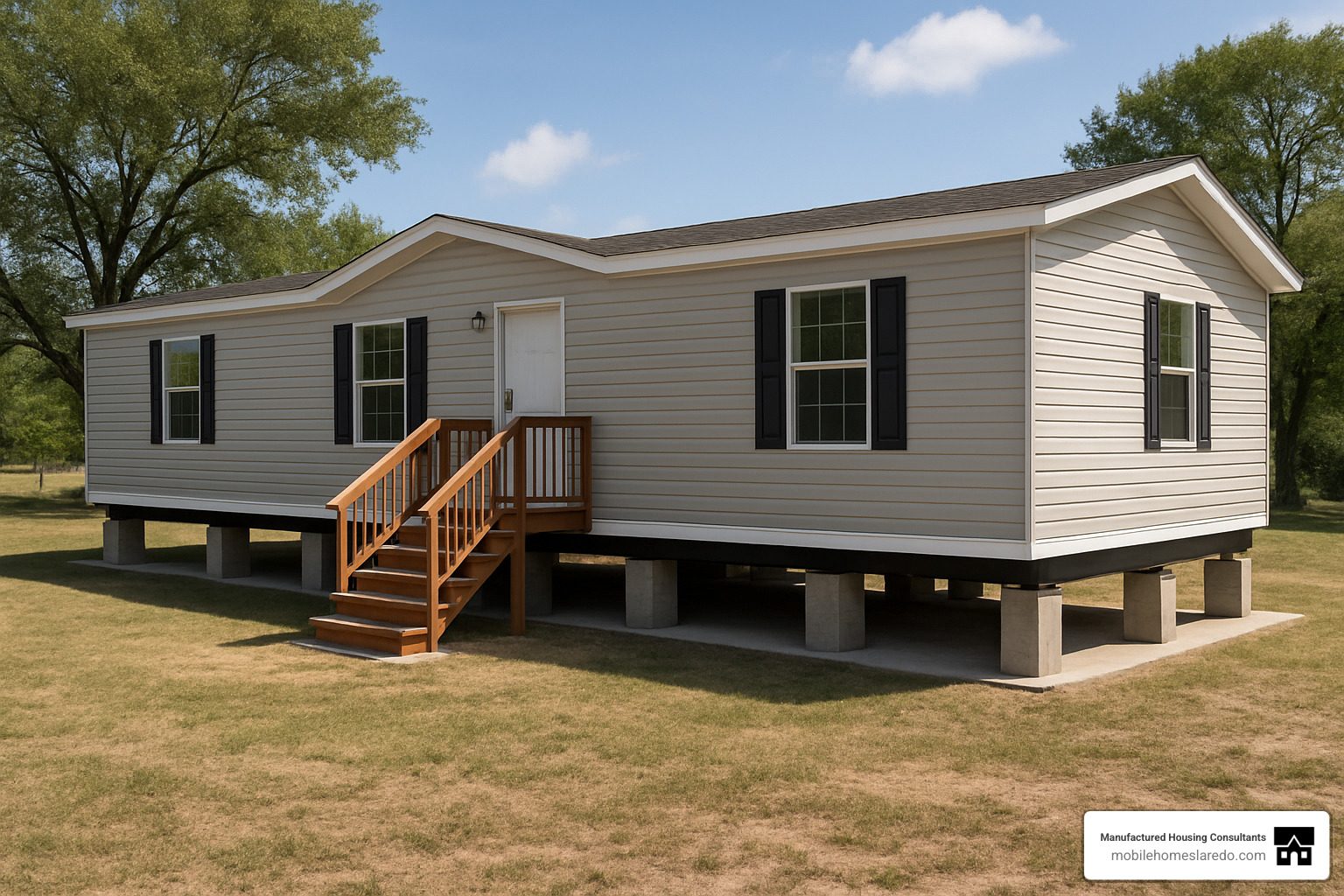The Foundation of Your Mobile Home’s Future
Types of foundations for mobile homes include five main options: pier and beam, slab-on-grade, crawl space/pit-set, runner strips, and basement foundations. Each serves different needs based on climate, budget, and long-term goals.
| Foundation Type | Cost Range | Best For | Financing Eligibility |
|---|---|---|---|
| Pier & Beam | $1,000-$8,000 | Flood zones, quick installation | May qualify as permanent |
| Slab | $4,000-$10,000 | Warm climates, budget-conscious | Typically permanent |
| Crawl Space | $6,000-$15,000 | Utility access, sloped lots | Permanent |
| Runner | $2,000-$8,000 | Dry climates, lightweight homes | May qualify as permanent |
| Basement | $12,000-$25,000 | Added living space, resale value | Permanent |
It’s said that a home is only as strong as its foundation — and when we’re talking about manufactured homes, this statement couldn’t be truer. Your choice of foundation affects everything from your home’s stability and safety to its financing options and long-term value.
As the HUD guide to foundation systems notes, “There is no single ‘best’ foundation system” — the right choice depends on your specific situation. Your foundation decision is similar to choosing good tires for your car — not the most exciting purchase, but it impacts everything about how your home performs over time.
For Maria in Texas, and many others like her seeking affordable housing, understanding foundation options is crucial. The right foundation can transform a manufactured home from a depreciating asset into a solid long-term investment.
Your foundation choice will be influenced by several key factors:
- Local climate (frost depth, flood risk, high winds)
- Soil conditions (clay, sand, rock)
- Budget constraints
- Financing requirements
- Long-term plans (permanent residence vs. potential relocation)
Making an informed foundation choice now can save thousands in maintenance costs later and potentially increase your home’s resale value by 10-30% according to industry experts.
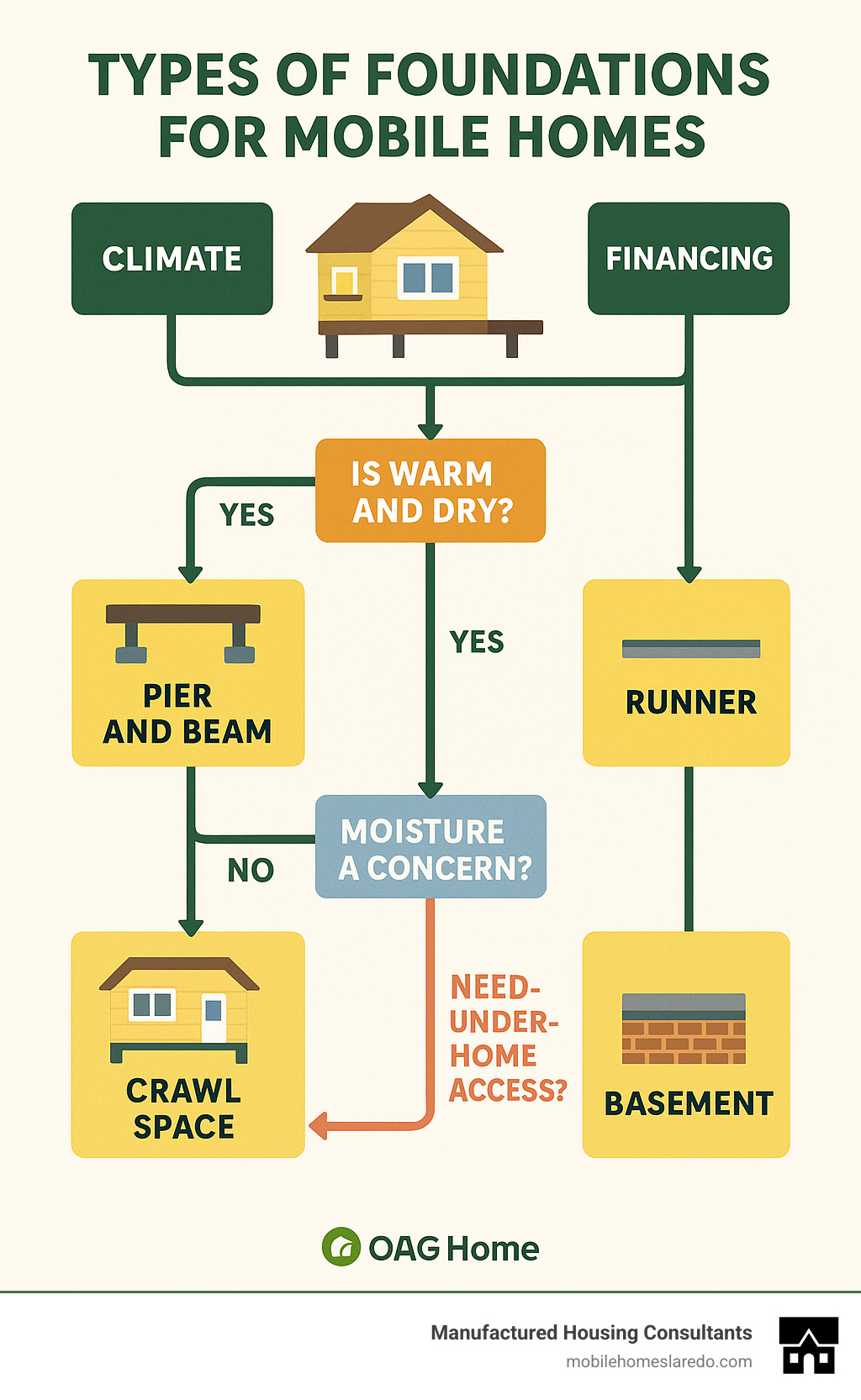
Comparing the 5 Best Types of Foundations for Mobile Homes
When it comes to setting up your mobile home, the foundation you choose makes all the difference in the world. It’s kind of like picking the right shoes for a long hike – get it wrong, and you’ll feel the consequences with every step!
Let’s explore the difference between permanent and non-permanent foundations before diving into your options.
Permanent vs. Non-Permanent Foundations
Think of permanent foundations as planting roots. They’re built to last 30+ years (the typical lifespan of your home), meet HUD’s official requirements, and transform your manufactured home into “real property” – just like a traditional stick-built house. This opens doors to better financing options including conventional mortgages, FHA loans, and VA loans with interest rates typically 2-5% lower than other options. That could save you tens of thousands over your loan term!
Non-permanent foundations, on the other hand, offer flexibility if you might relocate, cost less upfront, but often limit you to personal property loans with higher interest rates. They also tend to depreciate faster in value.
Here in Texas, foundation requirements vary widely from the coastal areas to the northern regions. Your local building codes, wind zones, flood plains, and frost depths all play a role in determining what’s allowed in your specific area.
Now, let’s walk through the five main types of foundations for mobile homes to help you find your perfect match.
Pier & Beam – Most Popular Types of Foundations for Mobile Homes
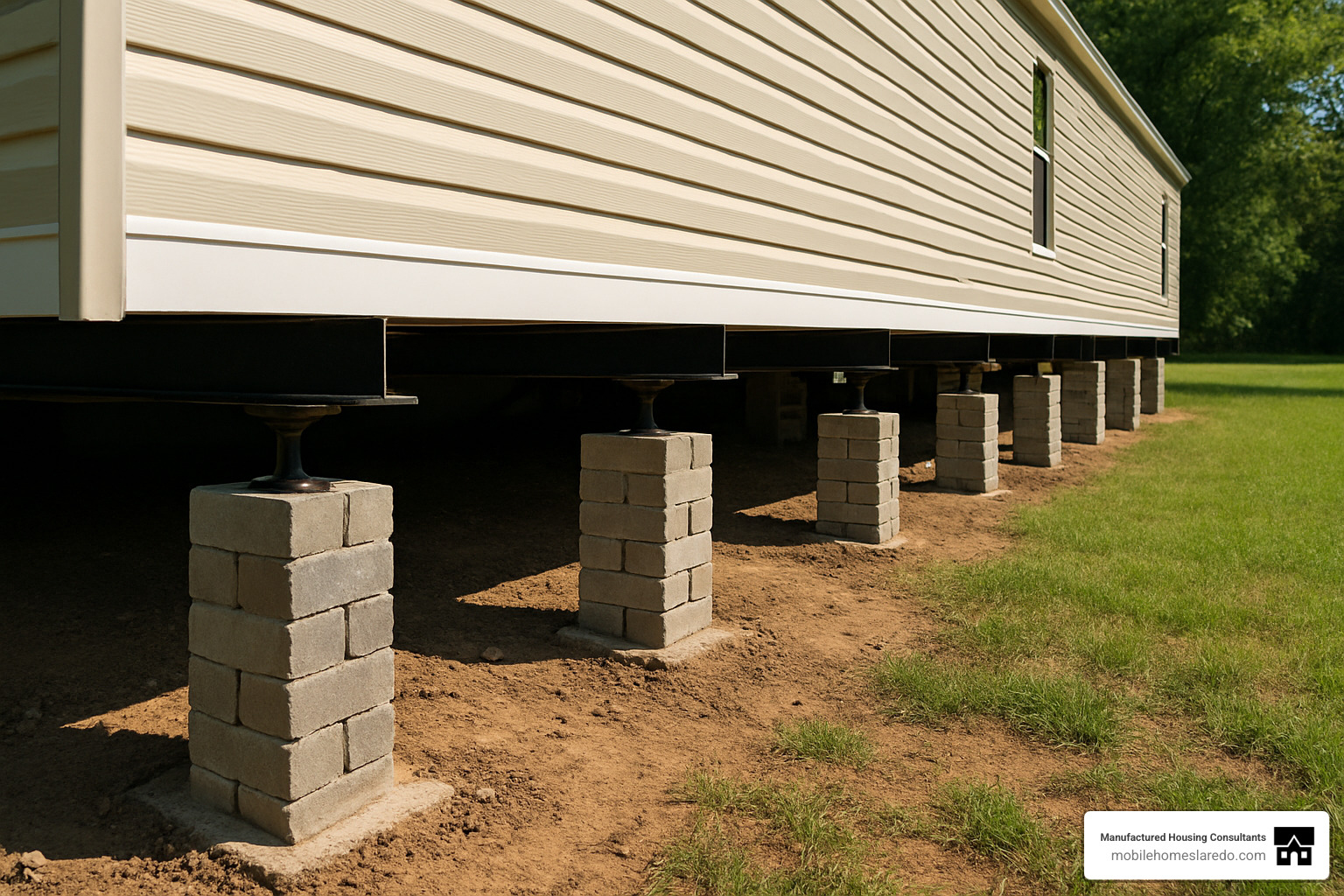
If foundations were a popularity contest, pier and beam would win by a landslide. This setup uses a series of piers (typically concrete blocks or steel supports) placed strategically under your home’s main beams and perimeter.
The magic of pier and beam comes from its simplicity. Concrete footings get placed below the frost line, with support piers on top, while steel straps and ground anchors keep everything secure in high winds. Most installations cost between $1,000-$8,000 depending on your home size and site conditions.
Why homeowners love it: Affordability tops the list, followed by quick installation (often just 1-2 days). It works beautifully on sloped lots, provides excellent under-home ventilation to prevent moisture problems, and offers easy access to plumbing and electrical systems. The lifted design also provides natural protection against minor flooding.
The downsides: You’ll need skirting for a finished look, and the space underneath can become an invitation for critters if not properly maintained. Insulation can be challenging in cold climates, and some loan programs may not consider it “permanent.”
Pier and beam foundations shine in Florida and other hurricane-prone regions when properly anchored according to HUD wind zone requirements. The HUD Permanent Foundations Guide provides detailed specifications based on your specific wind zone.
At Manufactured Housing Consultants, we often recommend pier and beam for our Laredo clients who want quick installation and have favorable soil conditions. It’s particularly well-suited for budget-conscious buyers, homes in flood-prone areas, sites with uneven terrain, and warm climates with minimal freezing.
For installation details, check out our mobile home installation guide.
Slab-on-Grade – Fast & Budget-Friendly
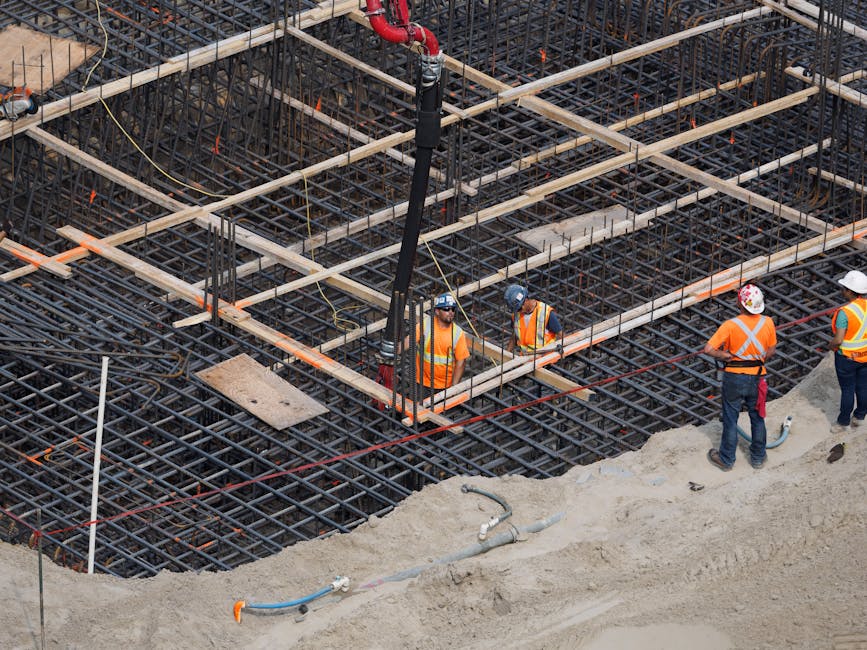
A slab foundation is exactly what it sounds like – a solid concrete platform for your home to rest upon. Unlike site-built homes where the slab is the floor, manufactured homes sit on top of the slab with their own flooring system.
A typical slab includes 4-6 inches of concrete over a gravel or sand drainage layer, with a vapor barrier underneath to keep moisture at bay. Reinforcement with rebar or wire mesh provides strength, while embedded anchor points secure your home against wind.
The major benefits: Stability is the standout feature – slabs provide a solid, level surface that resists settling. They’re reasonably priced ($4,000-$10,000), require minimal maintenance, create a natural barrier against termites, and generally qualify as permanent for most loans. Installation is relatively quick, with pouring and curing typically completed in 5-7 days.
The challenges: Once installed, accessing utilities becomes difficult. Slabs can transmit cold in freezing weather (unless you add special insulation), may develop cracks in expansive soils, and require proper drainage to prevent water problems. And forget about easily relocating your home – that’s not happening with a slab.
Slabs are most popular in warm climates where frost heave isn’t an issue. They perform beautifully in southern Texas around Laredo due to our minimal freezing. For colder regions, frost-protected shallow foundations (FPSF) incorporate insulation around the perimeter to prevent frost damage.
This foundation type is ideal for warm climates, level sites with good drainage, permanent home placement, areas with termite concerns, and buyers seeking permanence without breaking the bank.
Crawl Space / Pit-Set – Low-Profile & Accessible
Crawl space foundations (sometimes called pit-set foundations) give you the best of both worlds – the conventional appearance of a site-built home with the practical access to utilities that manufactured homeowners appreciate.
This design creates a shallow space beneath your home using perimeter foundation walls around a shallow excavation. Key components include concrete, block, or poured concrete walls, interior support piers, a vapor barrier over the soil, ventilation openings, and an access door.
What makes them special: The site-built appearance creates a low-profile, conventional look that many homeowners prefer. You maintain easy access to plumbing and wiring, qualify as real property for financing, and gain adaptability for sloped lots. The space can be insulated for energy efficiency and even provides limited storage beneath the home.
The drawbacks: Expect to pay more ($6,000-$15,000) than for pier and beam. Moisture concerns require proper ventilation and vapor barriers, and the space can attract pests if not properly maintained. Construction takes longer too – typically 3-5 days for the foundation plus 5 days for home installation.
Proper ventilation is non-negotiable with crawl spaces. The standard requirement is one square foot of vent area per 150 square feet of floor area, with vents positioned to create cross-ventilation. This prevents the moisture buildup that leads to mold, rot, and structural damage.
Crawl spaces are perfect for buyers wanting a site-built appearance, those with sloped lots where leveling would be expensive, areas with moderate frost depths, and homeowners who prioritize utility access.
For finishing touches, check out our guide on skirting for manufactured homes.
Runner Strips – Lightweight Solution
Runner foundations (sometimes called ribbon foundations) take a minimalist approach, using continuous concrete strips that align with the main support beams of your manufactured home. Think of it as focusing support exactly where it’s needed most.
These foundations typically include concrete strips (16-24 inches wide), reinforcement with rebar, footings below the frost line in cold regions, and anchor points for securing the home.
The advantages: Cost-effectiveness tops the list at $2,000-$8,000, using less concrete than a full slab. The continuous support along beam lines distributes weight evenly, installation happens faster than with slabs or crawl spaces, and there’s minimal site disruption. When properly designed, runners can qualify as permanent foundations.
The limitations: You’ll get less ventilation than with pier and beam, more difficult utility access, and they’re not ideal in areas with expansive soils. Some contractors may be less familiar with this foundation type, as it’s not as common as others.
Runner foundations perform best in dry climates with stable soil conditions and are particularly suitable for single-wide homes where support needs are more straightforward. For structural integrity, the concrete should cure for at least 7-10 days before home placement.
At Manufactured Housing Consultants, we sometimes recommend runner foundations for clients in drier parts of Texas who want something more permanent than pier and beam without the full expense of a slab or crawl space.
Basement Foundations – High-Value Types of Foundations for Mobile Homes

If you’re looking for the premium option, basement foundations create substantial additional living space beneath your home – the closest match to traditional site-built construction.
A basement foundation includes an excavated space matching your home’s footprint, reinforced concrete or block walls, interior support columns, waterproofing systems, drainage provisions, and stairway access from the home.
The impressive benefits: Added living space increases your usable square footage by up to 100%, maximizing resale value. You’ll qualify for the best financing options, gain abundant storage space, have a built-in storm shelter, and enjoy the natural insulation that earth-bermed walls provide.
The considerations: This is your highest-cost option at $12,000-$25,000+. Construction is complex, requiring specialized skills and equipment, and typically takes 2-4 weeks. Water management requires careful waterproofing and drainage, and basements aren’t suitable in areas with high water tables.
Basements account for roughly 80% of site-built home foundations in northern regions with cold climates, climbing to 90% in the Northeast and north-central states. Many manufactured home basements use insulating concrete forms (ICFs), combining structural strength with built-in insulation. Scientific research on insulating concrete forms) demonstrates their superior energy performance and durability.
On sloped lots, walk-out basements provide direct yard access and additional natural light – particularly popular in hilly regions.
Basement foundations are ideal for maximizing property value, cold climates where basements are common, buyers needing additional living space, long-term investment properties, and sloped lots suitable for walk-out design.
Cost & Performance Snapshot
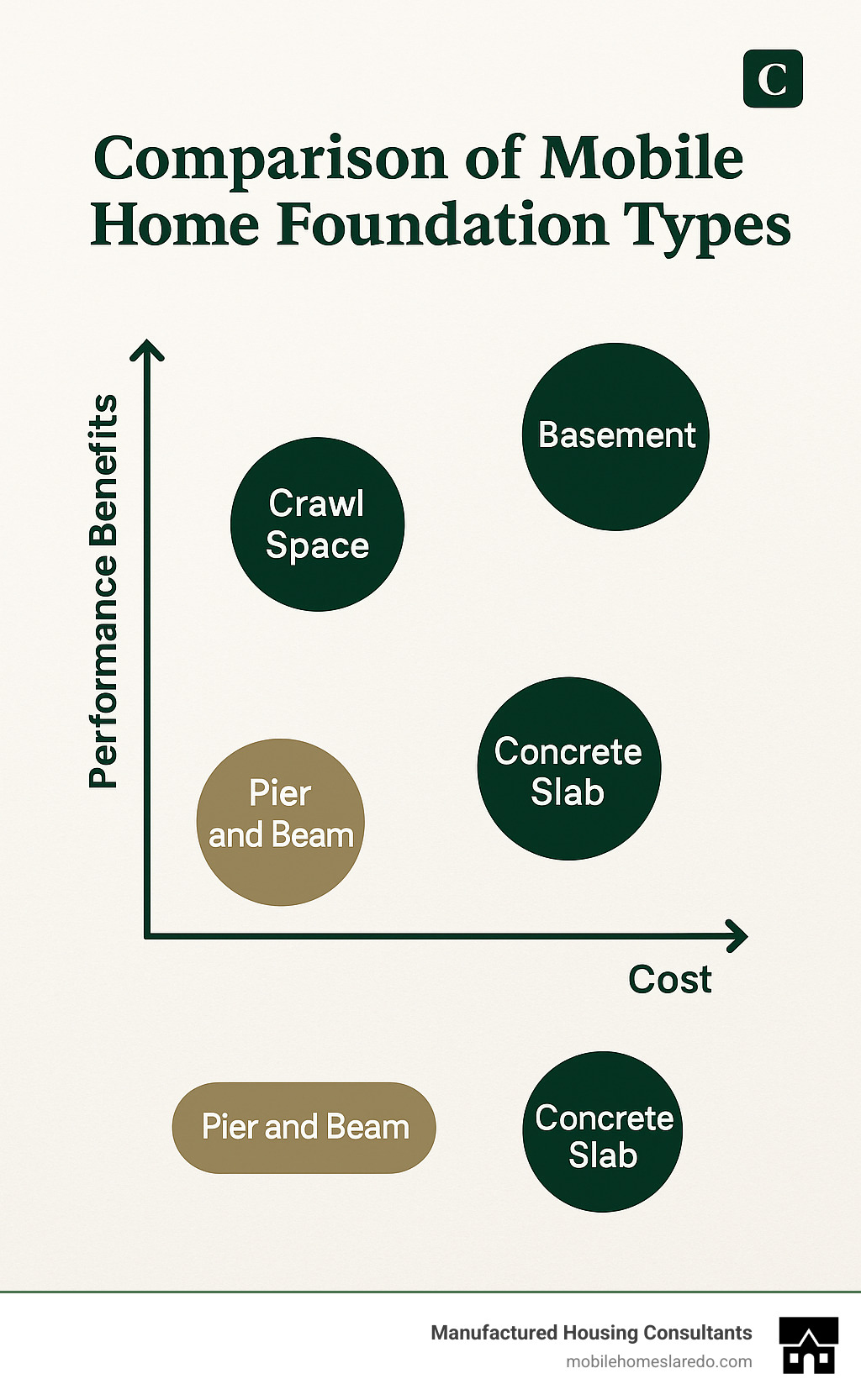
Here’s how the five types of foundations for mobile homes stack up against each other:
| Foundation Type | Cost Range | Installation Time | Maintenance Needs | Financing Eligibility | Best Climate Fit |
|---|---|---|---|---|---|
| Pier & Beam | $1,000-$8,000 | 1-2 days | Moderate | Sometimes | Flood zones, varied terrain |
| Slab | $4,000-$10,000 | 5-7 days | Low | Yes | Warm, minimal freezing |
| Crawl Space | $6,000-$15,000 | 8-10 days | Low-Moderate | Yes | Moderate frost, sloped lots |
| Runner | $2,000-$8,000 | 3-5 days | Low-Moderate | Sometimes | Dry, stable soil |
| Basement | $12,000-$25,000 | 14-28 days | Moderate-High | Yes | Cold regions, value-focused |
While your foundation typically represents 10-30% of your total home investment, it can dramatically impact your long-term costs and resale value. Think of it as an investment rather than an expense – putting more into your foundation often pays off through reduced maintenance headaches and better financing terms down the road.
At Manufactured Housing Consultants, we’re here to help you steer these choices based on your specific needs, location, and budget. The right foundation creates stability not just for your home, but for your financial future as well.
Selecting, Budgeting & Certifying Your Mobile Home Foundation
Choosing the right foundation isn’t just about cost—it’s about creating a secure home that meets your needs for years to come. Let’s walk through how to make this important decision together.
Climate Considerations
Your local weather patterns play a huge role in which foundation will work best for your home:
In northern Texas, frost can penetrate 12-18 inches into the ground, while here in Laredo, we’re fortunate to have minimal frost concerns. This difference alone can dramatically change your foundation needs.
Wind exposure matters too—especially if you’re in coastal areas of Texas (HUD Wind Zone III), where hurricane-force winds demand robust anchoring systems. Meanwhile, flood-prone areas often benefit from liftd pier and beam foundations that keep your home high and dry.
I spoke with Maria from Corpus Christi last month who initially wanted a slab foundation, but after reviewing her property’s flood elevation certificate, we recommended pier and beam instead—a decision that may save her thousands in potential flood damage.
Soil Assessment
The ground beneath your home tells an important story about which foundation will perform best:
Clay soils expand when wet and shrink when dry—a recipe for foundation movement if not properly addressed. Sandy soils drain well but might not provide the stability needed for certain foundation types. Rocky terrain offers excellent support but makes excavation challenging and potentially more expensive.
“Think of soil testing as cheap insurance,” as our foundation contractor Carlos often says. For $300-$1,000, a professional soil test can prevent headaches that might cost 20 times that amount to fix later. It’s one of the smartest investments you can make before finalizing your foundation choice.
Financing Implications
Your foundation choice directly impacts your loan options and monthly payments:
FHA and VA loans require permanent foundations certified by a licensed engineer. With interest rates typically 2-5% lower than chattel loans, this certification can save you tens of thousands over your loan term.
One of our clients, Robert, initially planned a simple pier and beam setup to save money. After learning he could qualify for an FHA loan with a permanent foundation, he upgraded to a crawl space design. His monthly payment actually decreased despite the higher foundation cost, thanks to the better interest rate.
For permanent foundation status under HUD guidelines, your foundation must be:
- Built with durable materials like concrete, masonry, or treated wood
- Permanently attached to the ground
- Designed to properly transfer all loads to the soil
- Built to withstand frost, settlement, and potential seismic activity
Engineer Certification
That official stamp from a licensed engineer isn’t just paperwork—it’s your ticket to better financing and peace of mind. The certification (typically $500-$1,500) confirms your foundation:
- Meets or exceeds HUD/FHA requirements
- Is designed for your specific soil conditions and climate
- Will support your home for its expected life (usually 30+ years)
- Complies with all local building codes
We can help connect you with qualified engineers throughout Texas who understand manufactured home requirements and can provide the documentation you need for financing approval.
Long-Term Maintenance
Different foundations require different care routines:
Pier and beam foundations need annual checks for settling and tie-down tightening. Slab foundations should be monitored for cracks and proper drainage. Crawl spaces require regular inspection of vapor barriers and ventilation to prevent moisture problems.
As Gloria, one of our long-term homeowners, puts it: “Ten minutes of inspection twice a year has kept my foundation perfect for 15 years.” Simple maintenance prevents costly repairs down the road.
Working with Manufactured Housing Consultants
At Manufactured Housing Consultants, we don’t just sell you a home—we guide you through every step of creating your perfect living space. Our foundation recommendations are based on:
- Your specific site conditions in Laredo or elsewhere in Texas
- Your budget constraints and financing plans
- Your long-term goals for the property
- Local building code requirements
We partner with qualified foundation contractors throughout Texas who understand the unique requirements of manufactured homes. From coordinating soil testing to arranging engineering certifications, we’ll help streamline the entire process.
The foundation may not be the most exciting part of your new home purchase, but it’s certainly one of the most important. We’re here to help you make a choice that provides stability, value, and peace of mind for years to come.
For more information about the various home styles available, check out our guide to types of mobile homes.
Conclusion: Building on a Solid Foundation
When it comes to your manufactured home, the foundation isn’t just what’s beneath your feet—it’s the bedrock of your investment. The right foundation choice echoes throughout your homeownership journey, influencing everything from your mortgage rate to how much you’ll enjoy living there.
Each of the types of foundations for mobile homes we’ve explored serves a unique purpose in the manufactured housing landscape:
Pier and beam foundations offer that sweet spot of affordability and adaptability that many Texas homeowners love. For folks in flood-prone areas or those watching their budget, this tried-and-true option delivers solid performance without breaking the bank.
Slab foundations bring peace of mind through stability and minimal upkeep. If you’re settling in for the long haul in our warm Laredo climate, a slab’s permanence and termite resistance make it worth considering.
Crawl space foundations give you that traditional home look while keeping your utilities accessible. It’s the “best of both worlds” approach that works beautifully on our region’s sometimes challenging terrain.
Runner foundations provide focused support where your home needs it most. This lesser-known option delivers surprising value for budget-conscious buyers, especially in our drier Texas regions.
Basement foundations transform your manufactured home investment by essentially doubling your living space. While they represent the highest upfront investment, they also offer the greatest potential return when it’s time to sell.
Your foundation typically represents between 10-30% of your total home investment. That percentage might seem substantial now, but choosing wisely at this stage prevents those middle-of-the-night worries about settling, shifting, or water damage down the road.
At Manufactured Housing Consultants, we’ve guided hundreds of families through this decision process. We understand that choosing between foundation types isn’t just about technical specifications—it’s about finding the right fit for your family’s future. Whether you’re prioritizing budget, longevity, or financing options, we’re here to help you steer these choices with confidence.
For an even deeper dive into foundation options and to understand exactly what documentation you’ll need for financing approval, visit our comprehensive manufactured home foundation guide.
Your home deserves to rest on a solid foundation—and so does your peace of mind. Let’s build both together.

